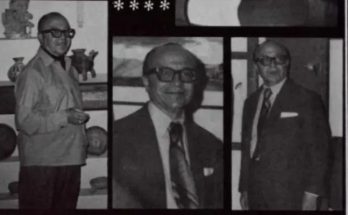By Luis Felipe Rodríguez
In Part I, we talked about the school of arts and crafts that opened in 1921 on the corner of San Francisco and Relox, and about some of the students who studied there. There was a great interest in sculpture during those years, and Donato Almanza Morales was one of the outstanding students. Donato taught sculpture to his children, Genaro, Francisco, Jesús, Lauro, Antonia, and Reynaldo. Their work was recognized, and they were given commissions in Tampico, and in Ciudad Mier (located in the Mier Municipality of Tamaulipas).
Genaro spent three years in Ciudad Mier, but nostalgia for San Miguel de Allende was strong, and he eventually returned. Jesús, however, liked Tampico and remained there, continuing to sculpt for the rest of his life. Lauro married a woman from Tabasco and moved there, though he left some pieces of his art in SMA. According to Father Roberto Almaguer, Lauro and his brother Genaro sculpted the altarpiece of the Three Hail Marys, the restoration of the Divine Shepherd, the Holy Child of Health, and gilded the altar and other works in La Salud church, by Plaza Cívica. Although Reynaldo finished his studies and became a teacher, his artistic streak led him to collaborate with his family on restoration work and his own pieces. Donato sculpted the statue of the founder of that congregation in SMA, Don Juan Antonio Pérez de Espinosa, which adorns the atrium of the church of San Felipe Neri.
Donato sent his son Francisco to the workshop of his former partner, José María, in Mexico City, where Francisco learned painting, sculpture, restoration, and gilding. When he returned to SMA, he shared what he had learned with his family.
Donato died on April 10, 1973. One year after his death, an exhibition of his religious art was held at the Mesón de San Ignacio to pay tribute to him. Works of art by other painters and sculptors from San Miguel were part of this exhibit. The San Miguel Student Club of the University of Guanajuato organized the event, and then-Mayor Silvestre Bautista López inaugurated it.
The following artists participated in this exhibit: Luis López Arriaga, with a baroque image of San Miguel Arcángel; Reynaldo Almanza, with a miniature of Christ in wood; José Rodríguez González, with a polychrome Nativity; Genaro Almanza, with an Ecce Homo; Jesús Almanza, with two religious paintings; Francisco Almanza, with a wooden crucifix and two Christs; Lauro Almanza, with a wooden sculpture entitled San Antonio Abad; David Juárez, with a colonial door; José Ramírez, with an Apostle’s Head; Leopoldo Ruiz, with a wooden Nativity scene; Antonio Ruiz, with a wooden sculpture called Pity and Christ; Braulio Echeverría, with several wooden figures; David Morales, with a candlestick; Martín Cadena Hernández with The Three Graces; Enrique Pérez, with a wooden sculpture of San Cristóbal; Gustavo Pérez Mata, with The Last Supper and two paintings of Camerino Quintanar.
Genaro continued the idea of exhibiting art, supported by Carmen Massip, director of the Ignacio Ramírez Cultural Center. An annual exhibition of Sacred Art took place annually until 2000. From Los Imagineros Sanmiguelenses by Luis Felipe Rodríguez, chronicler of SMA. The first part of this story was published in the April 21, 2022 issue of Atención.




